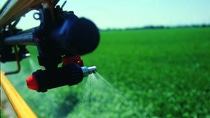Agriculture
F 500® – Broad Disease Control And Improved Plant Health
BASF has traditionally led the way in the search for new active ingredients to combat fungal diseases in cultivated plants. Over the years, our products have consistently set new standards.
The active ingredient F 500® offers speed and long-lasting effectiveness in controlling a broad range of key fungal diseases in sensitive populations in over 60 crops. These features mean that farmers have maximum flexibility and reliability in controlling diseases and improving the crops’ overall health. Overall benefits include potentially higher yields, better return on investment and, ultimately, enhanced farm profits.

Benefits
F 500® provides both preventative and curative effects, meaning that it can protect against new infections as well as stop the spread of already infected tissues. Even at very low application rates, F 500® is extremely effective and long-lasting. This is particularly useful in crops threatened by several pathogens simultaneously, such as cereals, grapes, fruits, vegetables or turf. In addition, F 500® enables more efficient nitrogen uptake, more robust plant growth and improved stress tolerance to heat, hail, wind and drought.

Mode of action
F 500® blocks fungal cells' energy supply and thus inhibits other vital functions. Upon contact with F 500®, the fungal cell membrane's energy-dependent pump systems shut down. Germination of fungal spores demands high energy supply. Germinating spores will be particularly sensitive to F 500®. In the area of plant health, F 500® reduces a plant's ethylene production, a key molecule in the ripening process. In this way, F 500® enables plants to remain vital for longer periods of time, ensuring both higher quality and quantity at harvest time.

BASF and strobilurines
BASF has pioneered the area of strobilurine research for more than twenty years. The strobilurine chemical structure was first isolated from a tiny forest mushroom, the pinecone cap. German scientists discovered that the pinecone cap was able to defend itself against other fungi by producing a substance with fungicidal effects. BASF then optimized this specific property in the development of Kresoxim-methyl, first registered for use in 1995. Further research led to the development of F 500®, first introduced in 2002. BASF continues to introduce product innovations around strobilurines, for example in mixes with Xemium®.